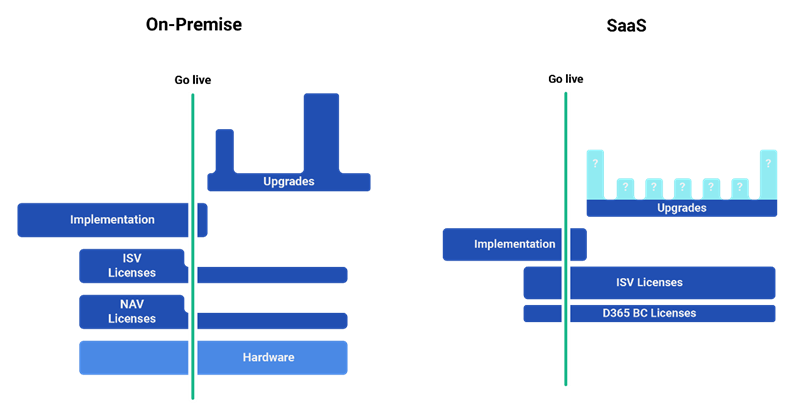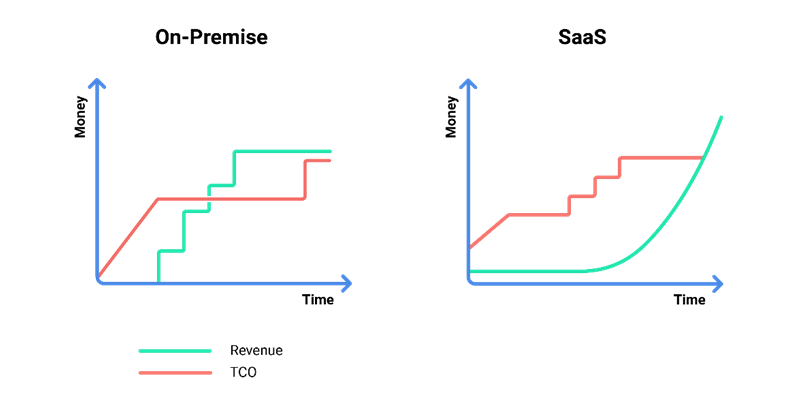Tuesday, September 22, 2020
Reading time: 8 minutes
This is the second part of a two-part blog series on “What to Expect When Moving Your Solution to Dynamics 365 Business Central SaaS and AppSource”. In Part 1 of the blog series the technical differences were covered. In this blog, I will cover the costs and operational differences of maintaining customer and ISV Business Central SaaS solutions vs. Business Central On-Premises solutions. If you haven’t read Part 1 yet, check it out now! You can also listen to a webinar on this topic here. Having the plan of how to keep solutions up to date on Business Central SaaS becomes even more important after Microsoft has released an official policy that you can read here.
In this blog post, we’ll cover the following:
- How Moving to Dynamics 365 Business Central SaaS Affects the Total Cost of Ownership for End-Customers.
- How Moving to Business Central SaaS Affects the Total Cost of Ownership for Independent Software Vendors (ISVs)
- Strategies to Adapt to Dynamics 365 Business Central Changes
- How to Efficiently Maintain a Solution on Business Central SaaS
- Risks When Scaling a Customer Portfolio
- 1ClickFactory’s Extension Maintenance Subscription
How Moving to Dynamics 365 Business Central SaaS Affects the Total Cost of Ownership for End-Customers
Calculating the Total Cost of Ownership (TCO) is an important part of the decision-making process when moving to Dynamics 365 Business Central SaaS. Let’s take a look at some of the essential differences between Business Central On-Premises and Business Central SaaS when calculating the TCO.

Picture 1: The comparison of Business Central On-Premises TCO vs. Business Central SaaS TCO for end-customers.
With Dynamics 365 Business Central On-Premises, customers face a cost for the hardware, ISV and NAV licenses, implementation and after the go-live, upgrades. Aside from this, customers are in control of when to upgrade. If the upgrades are simple, and the functionality improvements increase the productivity of the user, customers can choose to upgrade faster. However, if the upgrade costs are higher than expected, and the benefits of upgrading are relatively low, customers can postpone the upgrade until a later date.
With Dynamics 365 Business Central SaaS, hardware costs disappear, license costs change into a subscription model with no upfront investment and a relatively low monthly cost. The customer should expect to spend more on ISV software as it becomes more effective to buy ready-to-go software than to develop and maintain your own. Implementation costs stay the same. However, even though customers know the date of when to upgrade, they do not know the exact upgrade costs. The costs can be small if there are no Breaking Changes, or they can be significant if the functionality that the solution depends on becomes obsolete. In such cases a reimplementation is needed. To make matters worse, the upgrades become periodic and mandatory. Therefore, the upgrade process means that customers must commit to unpredictable costs in order to keep up to date on Dynamics 365 Business Central SaaS.
How Moving to Business Central SaaS Affects the Total Cost of Ownership for Independent Software Vendors (ISVs)
The total Cost of Ownership differs for ISVs as well.

Picture 2: The comparison of Dynamics 365 Business Central On-Premises TCO vs. Dynamics 365 Business Central SaaS TCO for ISVs.
A Dynamics 365 Business Central On-Premises solution has implementation costs for the first version of the solution. If there are no sales, the costs stay flat. However, if there is a mandatory update to support the newer Dynamics 365 Business Central release, there could be additional upgrade costs for the ISV Dynamics Partner. Given that ISV Dynamics Partners sell licenses through a Perpetual model, it is easily paid back as each sale of licenses has a substantial amount of revenue.
With Dynamics 365 Business Central SaaS, many ISV solutions reuse existing IP, which lowers the implementation costs. But once these solutions get to the Microsoft AppSource, ISV Dynamics Partners commit to supporting all major and minor Dynamics 365 Business Central releases. This means that once the new release comes out, an uncertain amount of effort is required to keep the solution up to date. Perhaps the sales of the solution on AppSource are not immediate and revenue grows slowly with a subscription-based licensing model. However, the solution must be maintained and remain up to date in order to get to the first sale. So even if there is no revenue, there is still the recurring solution maintenance cost.
Strategies to Adapt to Dynamics 365 Business Central Changes
The Dynamics 365 Business Central product evolution and changes impact TCO and challenge Dynamics Partners. Adapting to changes may seem hard but taking advantage of several strategies will make it easier and help partners to get ahead.
The most important thing we recommend is to test your solution early in order to gain time and better prepare for the upcoming changes. While testing is important, to get the customer’s solution technically ready for the next update, there is still more to do. It is also important to communicate the changes to the customer. There might be upcoming changes that are not related to the solution but may still affect the customer in some way e.g. functionality gets discontinued. Therefore, it’s a good idea to talk about upcoming change in advance and to include the customer in the user acceptance testing early, in order to avoid any surprises, particularly if the user interface changes. Most customers expect to get this information from their partners. It is a great opportunity for partners to monetize the periodic consulting on changes of the upcoming Dynamics 365 Business Central version.
It is also important to make decisions in advance as frequent updates require frequent and fast decision making. Usually, when changes coming with the new version have to be thoroughly tested and pass user acceptance before it is rolled out. Moreover, there is a short one-month window to do all of this. If partners wait too long, there will be a new final release available and partners will have to start everything from the beginning. Therefore, it’s a good idea to agree on a solution maintenance schedule beforehand with the customer. To help with planning the solution maintenance schedule, we recommend the following cadence after the official update of Dynamics 365 Business Central is released:
- Devote the first 2 weeks to implementing the adjustments.
- Spend the third week testing.
- Go live on the fourth week.
This way, everybody will be sure about what to expect in the future.
Knowing about the changes early helps to avoid peaks when distributing the workload. Even though obsolete functionality or code warning adjustments don’t have to be implemented straight away, it is not a good idea to leave them to the last minute to a point where the application won’t compile, and thousands of issues will have to be resolved before the Extension becomes compatible with the next major release of Dynamics 365 Business Central. Therefore, it is strongly advised to distribute the workload throughout the year and gradually adjust to the changes.
While following these strategies will increase chances of delivering the update on time, it is not enough because the customer might not want to pay for the unlimited number of hours required to deliver their solution on the new version of Dynamics 365 Business Central. Therefore, efficient implementation with reasonable costs is required.
How to Efficiently Maintain a Solution on Business Central SaaS
The best way to achieve efficiency is automation. It is not necessary to start with an entirely automated process. But if partners can automate the deployment of application to a newly created container of Dynamics 365 Business Central, run automated tests and see the results in PowerShell – it is a good start. Most repetitive tasks are the best first candidates for the automation.
However, the investment in automation depends on the size of the customer portfolio. It is not worth investing heavily in an automation with only a few customers in the portfolio. There will certainly be the administration overhead such as planning new releases, communicating when a customer has to perform user acceptance testing, informing the customer that changes are ready and following up after the new version of Dynamics 365 Business Central is released. If partner does not currently have a significant portfolio of customers, the investment in automation is most likely not a realistic option for either the customer or for the partner. To survive the transition period until partner grows the portfolio to a decent point, partner can buy field-tested tools that make him productive, or outsource Extension maintenance to the Dynamics Partners that have field experience, tools and processes already in place.
Risks When Scaling a Customer Portfolio
Even though maintaining more than one customer’s solution solves the automation problem, it also brings additional concerns and risks. Usually, with each Dynamics 365 Business Central release, there is a known effort of adjustments needed, such as testing and planning. However, until testing and the reimplementation of the code, a big part of the effort required to adjust to the Extension remains unknown for each release. This unknown part of the effort is easily manageable until the customer portfolio scales. When the number of customer solutions increases, the maximum potential of unknown effort hits the threshold of team capacity.
|
Picture 3: The fluctuation of effort for 10 customers. |
Picture 4: The fluctuation of effort for 100 customers. |
To solve this, partner should research the upcoming Dynamics 365 Business Central changes early. Partner can use code analyzers that provide hints about Obsolete states and warnings about what is going to be obsolete in a future Business Central release. It is highly advised to solve this in a planned manner rather than procrastinating until warnings will not allow to upload solution to Dynamics 365 Business Central SaaS.
The other thing to do is test the Extension often and early, with preview builds, to have more time to implement the changes. Partners should also follow the updates of upcoming Breaking Changes and prepare well in advance. That way, the efforts required will be spread over time making it possible to manage with a smaller team.
1ClickFactory’s Extension Maintenance Subscription
To help Dynamics Partners to keep their customer solutions up to date on Dynamics 365 Business Central SaaS, 1ClickFactory introduced an Extension Maintenance service. The service is applicable to Dynamics 365 Business Central Apps and Business Central SaaS customer solutions with Per Tenant Extensions and solves many challenges that Dynamics Partners face to keep solutions up to date.
1ClickFactory Extension Maintenance is offered for a fixed monthly fee. The service includes testing of the solution with each Dynamics 365 Business Central release and making the necessary adjustments such as dealing with restructuring, Obsolete State or platform changes.
Besides, if the Dynamics Partner’s automated tests need to be changed due to a major change in a Dynamics 365 Business Central release, 1ClickFactory updates the automated tests after agreeing the adjustments with the Dynamics Partner. 1ClickFactory can also develop automated tests for the Dynamics Partner. For automated test development, the Dynamics Partner should provide the test scenario documents or testing sequence report with ClickLearn software provided by 1ClickFactory.
Optionally, to maintain AppSource Apps, 1ClickFactory offers an AppSource pre-validation service. This service includes checking the App against the AppSource validation checklist and ensuring it complies with all technical requirements that change from time to time. The AppSource pre-validation service saves Dynamics Partners valuable time when submitting an App to the AppSource.
It’s important to mention that changes to Dynamics 365 Business Central are inevitable and so are the upgrades. The only way to get ahead of the competition is to adapt to the changes. This brings new opportunities for Dynamics Partners to scale. To find out more about how 1ClickFactory can help with Extension Maintenance, visit the 1ClickFactory website or contact us directly. You can also listen to a webinar on this topic.

